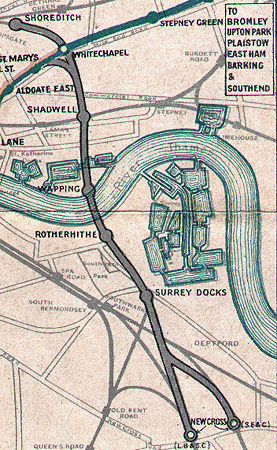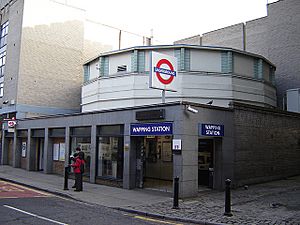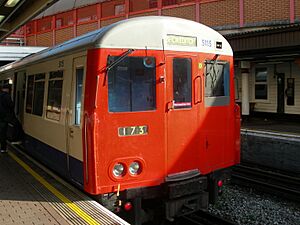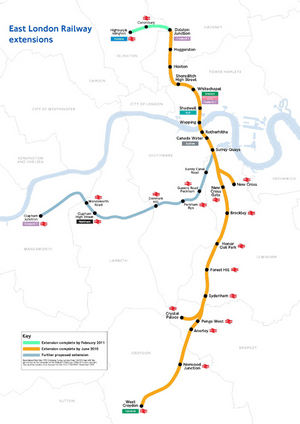East London line facts for kids
Quick facts for kids East London line |
|
|---|---|
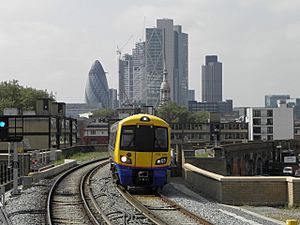
Class 378 train at Hoxton in 2010, with the City of London skyline in background
|
|
| Overview | |
| Status | Operational |
| Owner | Transport for London (TfL) Network Rail |
| Locale | Greater London |
| Termini | Highbury & Islington Dalston Junction New Cross Crystal Palace West Croydon |
| Stations | 23 |
| Service | |
| Type | Suburban rail, Rapid Transit |
| System | National Rail |
| Services | 3 |
| Operator(s) | London Overground |
| Depot(s) | New Cross Gate |
| Rolling stock | Class 378 "Capitalstar" |
| History | |
| Opened | 1933 to 2007 (As East London Line) 27 April 2010 (preview service) 23 May 2010 (full service) |
| Technical | |
| Number of tracks | Double track; sections with four tracks |
| Track gauge | 1,435 mm (4 ft 8 1⁄2 in) |
| Electrification | 750 V DC third rail |
The East London line is a railway line that runs through the eastern, Docklands, and southern parts of London. It is currently used by London Overground trains. Before this, it was part of the London Underground network.
The line was built in 1869 by the East London Railway Company. They cleverly reused the Thames Tunnel, which was originally made for horse-drawn carriages. The line became part of the London Underground in 1933. After almost 75 years, it closed on December 22, 2007, for a big upgrade and expansion. It reopened as part of the London Overground in April 2010. A second phase, which connected the line to the South London line and ended at Clapham Junction, opened on December 9, 2012. This created a railway line that goes around inner London.
In February 2024, the London Overground services on this line were given a new name: the Windrush line.
History of the East London Line
Building the Railway
The East London Railway (ELR) was created by the East London Railway Company. This company was a group of six different railway companies working together. Their goal was to connect railway lines from different parts of London.
They decided to use the Thames Tunnel, which was an amazing engineering feat built by Marc and Isambard Kingdom Brunel between 1825 and 1843. This tunnel was meant for horse-drawn carriages and connected Wapping (north of the Thames) with Rotherhithe (south of the Thames). Even though it was a great tunnel, it wasn't very successful for carriages.
Because the tunnel was the most eastern way to cross the Thames and was close to major railway lines, it was perfect for a new rail link. In 1865, the East London Railway Company bought the tunnel. Over the next four years, they built a railway through it to connect with existing lines.
The railway opened in different stages as money became available:
- December 7, 1869: The section from New Cross Gate to Wapping opened. It included stations at Deptford Road (now Surrey Quays) and Rotherhithe.
- March 13, 1871: A short branch line opened near Surrey Quays station, connecting to the South London line. This branch was later removed but was rebuilt and reopened in 2012.
- April 10, 1876: The line extended from Wapping to Shoreditch. This part of the tunnel was built in a unique way, partly along the bottom of a filled-in dock. New stations at Shadwell and Whitechapel also opened.
- April 1, 1880: A branch line to New Cross opened.
- March 3, 1884: A connection was made south of Whitechapel. This allowed trains from the Metropolitan and District Railways to use the East London Railway.
Early Train Services
The East London Railway Company owned the tracks, but other railway companies ran the trains. At first, steam trains were operated by the Great Eastern Railway, London, Brighton and South Coast Railway, and the South Eastern Railway. The line carried both passengers and goods.
In 1905, the Metropolitan District Railway stopped using the East London Railway because their own lines were electrified. The Metropolitan Railway also stopped its service in 1906. However, other services continued.
The East London line itself was electrified, meaning it could use electric trains. Electric services started on March 31, 1913. These trains ran from the southern stations to Shoreditch and other parts of London. In 1914, the service was changed to connect with what is now the Hammersmith & City line.
After 1923, the goods service was run by the London and North Eastern Railway. The Metropolitan Railway continued to provide passenger services.
The London Underground Years

In 1933, the East London Railway became part of the London Passenger Transport Board. Even though the tracks were still privately owned, passenger trains were run as a branch of the Metropolitan line. In 1948, all railways in Britain became national property.
Goods trains continued to use the line until 1962. The short track connecting Shoreditch to Liverpool Street was removed in 1966. The service to Shoreditch was reduced, with Whitechapel becoming the main northern end of the line. Shoreditch station eventually closed in 2006.
Over time, the East London line became more connected to the rest of London's transport system. In 1987, Shadwell became an interchange with the Docklands Light Railway. In 1999, a new station was added at Canada Water, allowing passengers to change to the Jubilee line.
The line was completely closed for major repairs between March 1995 and March 1998. During this time, buses replaced the trains.
The East London line's identity changed a lot during its time as part of the Underground. On Tube maps, it was first shown in the same color as the Metropolitan line. Later, it got its own distinct orange color on the map. Before it temporarily closed in 2007, about 10.7 million passengers used the line each year.
Line Features
The East London line was the only Underground line that didn't go into Travelcard Zone 1. It was also one of the few lines originally built for larger mainline trains. It was about 5.6 miles (9 km) long, making it one of the shortest lines. It had nine stations, and a trip from one end to the other took about 14 minutes.
Much of the line ran in tunnels, especially from Whitechapel to Surrey Quays. The deepest point was at Wapping station, which was built 60 feet (18 meters) below the surface in the original Thames Tunnel entrance.
It connected with other train services at New Cross and New Cross Gate. Underground connections were at Canada Water (Jubilee line) and Whitechapel (District and Hammersmith & City Lines). There was also a connection to the Docklands Light Railway at Shadwell, though passengers had to walk a short distance outside to change trains.
Most of the line had two tracks, allowing trains to go in both directions. However, some sections, like Shoreditch station and the very ends of the line at the southern stations, only had one track. This meant trains had to take turns using those sections.
Trains Used
The East London line used A60 and A62 sub-surface trains, which were built between 1960 and 1962. These trains were updated between 1995 and 1998 with better suspension, lighting, heating, and ventilation.
The trains on the East London line were usually four cars long, with a driver's cab at each end. This was different from most Metropolitan line trains, which were often eight cars long. Seven four-car trains usually operated the line. Because there were only a few trains, any problem like a train breaking down or staff shortages could cause big delays.
Stations on the Underground Line
Here are the stations that were in use during most of the East London line's time as part of the London Underground, from north to south:
| Station | Opened | First Underground Service | Notes |
|---|---|---|---|
| Shoreditch | April 10, 1876 | March 31, 1913 | Closed on June 9, 2006, before the line closed for its big upgrade. |
| Whitechapel | April 10, 1876 | March 31, 1913 | You could change here for the District and Hammersmith & City Lines. |
| Shadwell | April 10, 1876 | October 1, 1884 | You could change here for the Docklands Light Railway. |
| Wapping | December 7, 1869 | October 1, 1884 | This station is part of the Thames Tunnel. |
| Rotherhithe | December 7, 1869 | October 1, 1884 | This station is also part of the Thames Tunnel. |
| Canada Water |
August 19, 1999 | August 19, 1999 | A new station that opened for changing to the Jubilee line. |
| Surrey Quays | December 7, 1869 | October 1, 1884 | This station was first called Deptford Road, then Surrey Docks, and finally Surrey Quays. |
| The line splits here | |||
| New Cross Gate | December 7, 1869 | October 1, 1884 | You could change here for Southern mainline trains. |
| New Cross |
April 1, 1880 | October 1, 1884 | You could change here for Southeastern mainline trains. |
Becoming the Overground
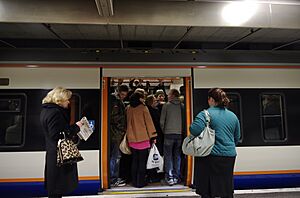
Work to extend the East London line extension began in 2005. The Underground service on the line ended in December 2007.
During the closure, special bus services were put in place to help people get around. These bus routes had names like ELW, ELS, ELC, and ELP. They ran for different periods, with some being stopped due to low passenger numbers. For example, the ELP route between Canada Water and Rotherhithe was stopped in February 2008 because not many people used it.
A limited train service on the newly upgraded line started on April 27, 2010. The full service began on May 23, 2010.
History of the Extended Route
The northern part of the extended route, mostly on raised tracks, opened in 1865. It was built by the North London Railway to connect its passenger trains to the City of London. This line originally had four stations, including a large end station called Broad Street.
At its busiest, Broad Street was one of London's busiest stations. However, traffic on the intermediate stations slowed down because of competition from buses and trams. Some stations closed after being damaged during World War II. The line remained busy until the 1950s but declined afterward and closed on June 30, 1986. The land where Broad Street station stood was sold for office buildings. The route north of Broad Street was kept but not used for many years. The current Haggerston and Dalston Junction stations are built near or on the old sites. Shoreditch High Street station is on a new path that connects the old and new routes.
Line Extension
Phase 1 of the Extension
The old East London line was extended north from Whitechapel. New stations were built at Shoreditch High Street, Hoxton, Haggerston, and Dalston Junction. This used 2.2 miles (3.5 km) of new tracks and old, unused tracks. A further extension to Highbury & Islington opened in February 2011.
The line was also extended south to connect to the Brighton Main Line near London Bridge. This part mostly uses existing tracks, running south to West Croydon. It includes stops at Brockley, Honor Oak Park, Forest Hill, Sydenham, Penge West, Crystal Palace (on a branch line), Anerley, and Norwood Junction.
Most of Phase 1 of the East London line extension officially opened on May 23, 2010. It was expected that the number of passengers would greatly increase, from 10.4 million to 35.4 million per year. Transport for London bought 20 new four-car Class 378 Capitalstar electric trains for the line.
The tracks and the northern extension are owned by Transport for London (TfL). The stations from Dalston Junction to Surrey Quays are part of the London Overground network.
Highbury & Islington Extension
The line was extended north to Highbury & Islington on February 28, 2011. This was two months earlier than planned. Now, eight trains per hour run on this section for most of the day.
Phase 2 of the Extension
A further 6.7-mile (10.8 km) link opened in 2012. This connected the line from south of Surrey Quays to Clapham Junction via the South London line. It included stations at Queens Road Peckham, Peckham Rye, Denmark Hill, Clapham High Street, and Wandsworth Road. A new station at Surrey Canal Road was planned, but this was put on hold.
The service from Highbury & Islington to Clapham Junction started on December 9, 2012.
Longer Trains
To handle more passengers, the Class 378 trains used on the line have been made longer, now having five cars. While most new stations have long enough platforms, some older stations cannot be extended. This means that at some stops, only certain doors on the train will open.
Train Services
The East London and South London line services are now known as the Highbury & Islington to New Cross, Clapham Junction, Crystal Palace, and West Croydon routes. As of December 2023, here is how often trains typically run during off-peak hours:
| Route | Trains per hour (tph) | Stops at |
|---|---|---|
| Dalston Junction to New Cross | 4 |
|
| Dalston Junction to Clapham Junction | 4 |
|
| Highbury & Islington to Crystal Palace | 4 |
|
| Highbury & Islington to West Croydon | 4 |
|
A special night service runs on Fridays and Saturdays between Dalston Junction and New Cross Gate. This service started in December 2017.
New Name: Windrush Line
In July 2023, Transport for London (TfL) announced that each of the six London Overground services would get its own unique name. In February 2024, it was confirmed that the service running on the East London and South London lines would be called the Windrush line. This name honors the Windrush generation of immigrants who came to the area from the Caribbean. On the updated network map, this line is now shown in red.
See also
 In Spanish: East London Line para niños
In Spanish: East London Line para niños


